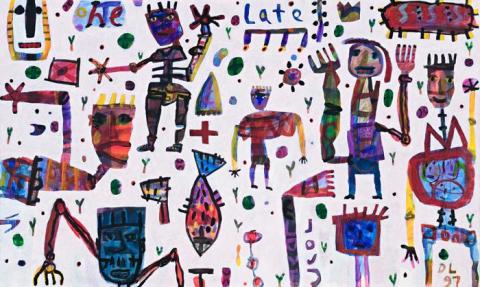NEVER BE LATE, 1997
David Larwill
oil on canvas
183.0 x 305.0 cm
signed and dated lower right: D.L. ‘97 signed, dated and inscribed with title verso: “Never be Late”/ David Larwill / 1997
Gould Galleries, Melbourne
Private collection, Melbourne
The year 1997, when Never be Late was painted, was an important one for David Larwill. Solo exhibitions were held in Sydney and Melbourne, and Craftsman House published a handsome monograph on his art, written by Ken McGregor. Anthony Clarke in The Australian summed up the feeling of the time. 'At the age of 41, Melbourne artist David Larwill is staking his claim as one of our leading artists of his generation.'1 This was no flash in the pan occasion, for Larwill already had an envious reputation. One of the founding members of ROAR Studios, his early successes included the acquisition of paintings by the National Gallery of Victoria and the National Gallery of Australia, the former having acquired its third Larwill by 1984. Two years later he was commissioned by the Victorian Ministry for the Arts and Metropolitan Transit Authority to paint one of Melbourne's W-class trams. Commissions from Australian Opera, a painting for the Australian Football Hall of Fame, and the tapestry Celebration followed, the latter a gift from Victoria to Singapore's new Esplanade Art Centre. In 2002, his hometown gallery, the Ballarat Fine Art Gallery organised the touring exhibition David Larwill: Stuff that Matters.
With an engaging personality and strong character, Larwill has a passionate commitment to painting, blended with a touch of the larrikin and maverick, his interest in street art and graffiti coming out in his bold and cheeky imagery. As Ashley Crawford observed, 'His stance, like his work, is deliberately naive and simplistic. Yet Larwill is no fool: his career has been a careful balancing act between public clown and careerist.'2 Early influences included the CoBrA group, especially Karel Appel and Asgar Jorn, and Jean Dubuffet of Art Brut, together with the colour and 'all over' design of traditional kilim rugs. Experiences gained from visits to locations as diverse as the Northern Territory and New were also influential. Larwill's art is often highly autobiographical. Personal narrative combined with strong visual appeal comes to the fore in Never be Late and other 1997 paintings such as Tanya goes to Melbourne - a farewell diptych to his erstwhile partner, the painter and sculptor Tanya Hoddinott. In addition to his engaging sense of colour, a feature of his art is the absence of a central image or single focus, his broad canvases populated by animated figures of people, dogs, snakes, trees and fish (Larwill loves fishing.) They are invariably things familiar to him. In his more political works he adds a keen social conscience, and in others he celebrates the joyous side of life - friendships, footy, and dogs.
1. Clarke, A., 'Fleeting brushes with pleasant fame', The Australian, Sydney, 28 November 1997, p. 17
2. Crawford, A., 'Portrait of the artist as larrikin', Age (Today), Melbourne, 1 September 1999, p. 7
DAVID THOMAS
